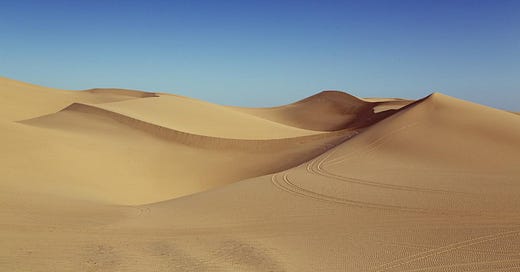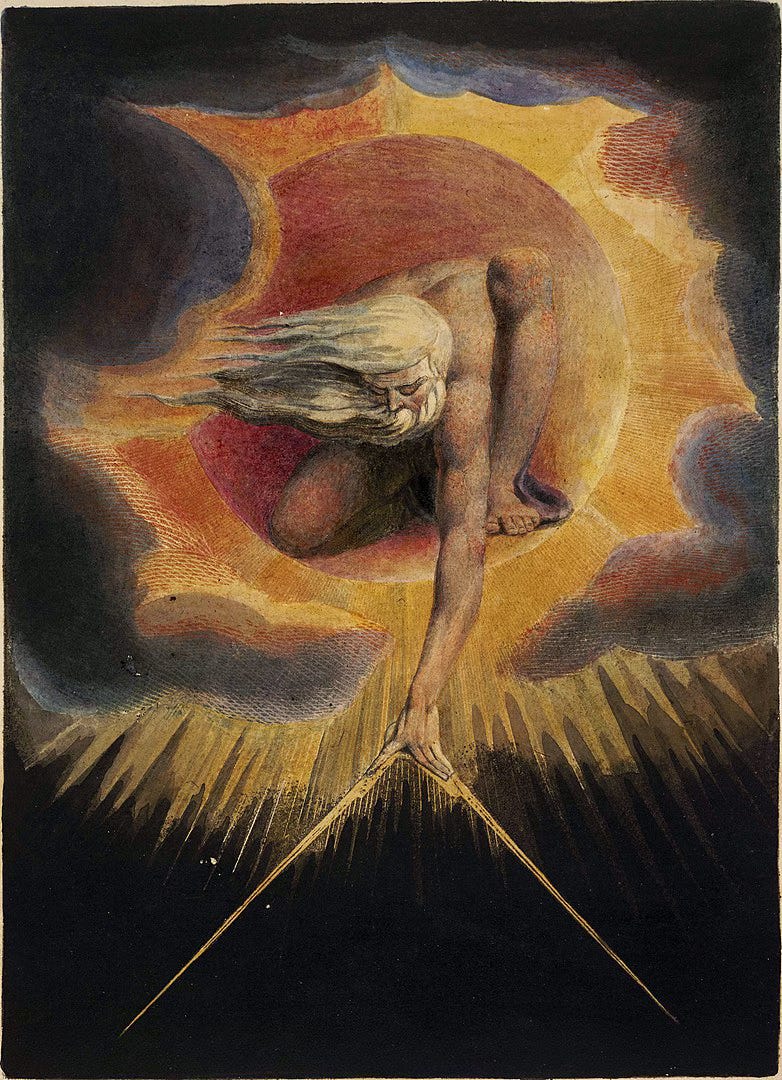Deep in the Mojave Desert, near the border between California and Nevada , the prevailing winds blow down from the north, rubbing bits of feldspar and quartz off the nearby Cottonwood Mountains before blasting south across Death Valley. There they run unchecked until they meet the riven sides of Tucki Mountain. Shrugging its square shoulders above the valley floor, the peak blocks the wind’s path, forcing it to slow. The great gusts drop their bits of far-flung stone so that, near the center of the valley, at the foot of the mountain, rise the Mesquite Flat Sand Dunes.
The day after Christmas, I met my brother-in-law at his house in southwestern California, and we packed up a van full of nieces and nephews, snacks and water bottles. It had rained a little the night before, and the sparse slopes of the foothills bloomed with rich scents of creosote and sage. The highway we took curved beneath the foothills of the Sierra Nevadas, past China Lake Naval Base and the rusting pipes of the Trona borax mines, their broad flats reeking of sulfur, white as the moon. From there we drove alongside Telescope Peak, where the fighter jets sometimes roar up the valley in formation, startling hikers and motorists alike. Then the road took us up through a mountain pass and down, down to the lowest point in North America.
I’ve seen many sand dunes in my life, from Great Sand Dunes National Park in Colorado, where competing winds along the Sangre de Cristo Mountains pile the sand up and up, to Sleeping Bear Dunes in northern Michigan, where gusts over the Great Lakes heap sediment left by Ice Age glaciers. These are not the most beautiful places I have travelled. Not the most dramatic nor the most awe-inspiring. But there is something that keeps drawing me back to them, in Colorado and Michigan, Indiana and California. My brother-in-law parked the car and we all tumbled out into the warm sand and blazing sun.

When humans contemplate the infinite, we tend toward two metaphors: sand and stars. In Genesis, God promises Abraham “descendants as numerous as the stars in the sky and as the sand on seashore.” In The Brothers Karamozov, Ivan muses that “in some future time, we shall find that all this, our history, our planet, was no more than a grain of sand, a fleeting moment in the infinite desert of eternity.” The metaphors are so culturally prominent that writers often use one to describe the other. Both the famed scientist Carl Sagan and the French novelist Antoine de Saint-Exupéry (writer of The Little Prince), explained the number of stars in the universe as comparable to the grains of sand on an enormous beach.
As I stood on the dunes, watching day trippers and retirees, the toddlers and teenagers, all flailing on the shifting sand, I knew I had no concept of such numbers. If I counted out the years of my life from this sweeping mass—a grain for each one—they would barely cover my palm. If I counted out the days, they would not fill my backpack. The minutes would not fill the van we drove here. The seconds would not fill my bedroom back home in chilly Iowa. The parabolic curves of the dunes whispered of expanses I could not fathom stretching immeasurably past the borders of my little life. I took off my shoes and let my feet press into their corner of infinity.
In the 3rd Century B.C., the mathematician Archimedes wanted to prove that humans could calculate numbers larger than they’d ever imagined. We could, he believed, conquer infinity. In a letter to the King of Syracuse, he set out to determine how many grains of sand it would take to fill the entire universe.
There are some, King Gelon, who think that the number of the sand is infinite in multitude . . . But I will try to show you by means of geometrical proofs, which you will be able to follow, that, of the numbers named by me and given in the work which I sent to Zeuxippus, some exceed not only the number of the mass of sand equal in magnitude to the Earth filled up in the way described, but also that of the mass equal in magnitude to the universe.
And so he begins. First he estimates how many grains of sand would equal one poppyseed (about 10,000). Then he counts the number of poppyseeds in one dactyl (the Ancient Greek measurement based on the width of a finger, about 3/4 of an inch). Then he calculates how many poppyseeds would fit in a sphere one dactyl in diameter. Then how many of those spheres side-by-side would span a Greek stadium. Then how many dactyl spheres would fit into a stadium-sized sphere. Then how many stadium-sized spheres would fit into the universe (which he estimated to be about two light years across). He concludes that a universe filled with sand would hold 10^64 grains (that’s 1 followed by 64 zeros).
This is particularly impressive because when Archimedes began his work, the largest number in the Greek system was a myriad or 10,000. He conceptualized larger and larger numbers by trying to imagine a myriad myriads (100,000,000) then a myriad, myriad, myriads and so on, showing the king that by simply multiplying numbers, by moving step-by-step from sand grains to poppyseeds, from finger-widths to stadiums, from stadiums to stars, he could measure what many believed to be unmeasurable.
We now know, of course, that the universe is far bigger than two light years across. Scientists estimate it is approximately 93 billion light years in diameter—465 myriad myriads bigger than Archimedes imagined. He could measure his infinity, but that which he took for infinity grew. We can measure what we never thought possible; then what we never thought possible grows past our measurements.
That day in Death Valley we set off barefoot across the sand. The teens joked and teased each other until they fell behind, and it was just me and my brother-in-law struggling up the slopes. When you hike on sand, especially sand as steep as this, you find muscles you didn’t know you had, little sinews in your hips, knees, and ankles that keep you from falling as the ground moves under you, a dozen tiny adjustments with each step. As we reached the top of the highest dune, a high layer of cirrus blew in across the sky. The light turned eerie, bright but gray. I looked out across wave upon wave of sand stretching to the far mountains. If any kind of god exists, it gestures to itself here in these dunes forever exceeding me, these gently curving myriads intimating the unfathomable.
Since Archimedes, mathematicians have gone on to prove that there are levels of infinity. Like the ranks of Dante’s heavenly angels, it is possible for one infinity to be larger than another. This makes no sense at first. Doesn’t the very word “infinity” mean “encompassing everything” or “that which nothing is greater than”? Apparently not. In the late 1800s, Georg Cantor wrote a proof, now widely accepted, which demonstrated that the infinity of all the decimals between 0 and 1 (0.1, 0.11, 0.12, 0.125 just to name a few) is greater than the infinity of all natural numbers (1, 2, 3, 4 etc.). I can almost wrap my brain around this idea (nope, not quite) but people smarter than I affirm its truth. I’m fascinated that the infinity bounded by constraints (the decimals between 0 and 1) is larger than the infinity bounded only on one side (starting with 1 and ascending beyond Archimedes’ myriad myriads). Cantor found a path to infinity similar to William Blake’s:
To see a World in a Grain of Sand And a Heaven in a Wild Flower Hold Infinity in the palm of your hand And Eternity in an hour
Infinity, which by definition seems free of all limit, exists at its greatest within limits. Paradox of paradoxes. But a hopeful one for my puny human life.
At the turn of each year, I’m tempted to count the sands of the last: books read, songs listened to, miles travelled, calories eaten, pounds gained, pounds lost. Again and again I run the numbers, hoping they’ll amount to something—I never quite know what. Maybe a sign that this year, at last, I’ve found infinity within constraints, lived a myriad of myriads, discovered god, conquered death. Of course if I had, I probably wouldn’t be sitting here counting.
How does one find it, this infinity within a lifespan? Some say meditation, some say sex, some say prayer, some say drugs. I’ve tried them all. For now, I’ll keep hiking the dunes of this earth, feeling with my soles the shifting sands that some men swear they can count.
Some books that helped me brush up against infinity last year:
If you want a book to remind you that our daily lives aren’t as limited as they seem, read Werner Herzog’s memoir Every Man for Himself, and God Against All. Herzog has led a fascinating life: from an impoverished childhood in the mountains of Bavaria, to drifting years as a young adult (he worked as a rodeo clown in Mexico, I kid you not) to an artistic career that included hauling a boat over a mountain and scaling the barbed-wire of a NASA facility. He points out in the book that he never achieved the impossible. He simply executed exactly what was possible.
If you want a book about humanity’s relation to infinity, read Gravity and Grace by Simone Weil. A Jewish mystic taken with both Catholicism and leftism, Weil’s short life began in France, then Spain, then England, where she fled the Nazi occupation and later died at age thirty-four. Gravity and Grace reads like a collection of aphorisms that lay out Weil’s complex philosophy of eternity and morality.
If you want a collection of poems about infinity, read Stray Truths by Euphrase Kezilahabi. A Tanzanian poet and novelist, Kezilhabi writes in Swahili and created some scandal by breaking with the strict meter and rhymes popular in that language’s poetry. He became the first Swahili poet to write in blank verse. His poem “Consciousness” (translated by Annemarie Drury) is one of my absolute favorites.







